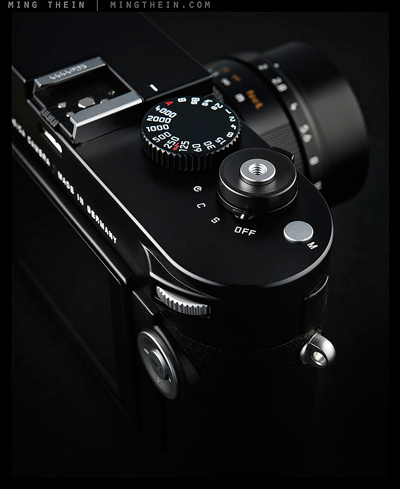Looks like February 22, 2013, is the day the Leica M Typ 240 embargo ended. We’re pampered with three excellent introductory reviews by versed photographers Sean Read, Jonathan Slack and Ming Thein. They’re all must read, and all three take different approaches. Reid’s review — subscription only — is very detailed, Jono’s written from a real world perspective with photos that breath. Ming’s finally is, as all his thoroughly enjoyable reviews, a highly elaborate, technical work with a layer of even poetic dimension.

1. Sean Reid — Leica M (240): Studio Tests of Beta Cameras
As always, the state-of-the-art Reid reviews are not free. The (free) intro says:
In order to give Leica feedback on the pre-production M (240) I did a number of detailed studio tests
to look at the camera’s performance in comparison to the Leica M9 and Leica M Monochrom.
Reid has done a meticulous report on the differences between the M DNG files and those of the M9. In a nutshell he’s saying that the M Typ 240 offers a 1.5-stop increase in ISO from the M9. In terms of resolution there’s not much difference from the predecessor.
As there are still no final RAW camera profiles available, the M files look almost 100% identical to M9 images when resized to the same pixel dimensions.
1.5 stops don’t sound like much, but according to Reid the M will still produce usable results under decent lighting up to maximum ISO 6,400 which is more than two stops higher than the M9’s highest ISO. But, according to Sean, Leica is calling ISOs greater than 3,200 “Push” ISOs which can look rough under certain difficult lighting.
Remember that the M9’s maximum ISO 2,500 was hardly usable. The better the light, the better the M’s high ISO performance will be.
Update: Luminous Landscape has Reid’s Impressions of the Beta M Leica (240).
2. Jonathan Slack — Testing the Leica M (240)
Jono’s work is not the one of a pixel peeper, it’s the impressions of a working photographer. He writes:
I’ve shot something like 10,000 images with the camera, both in RAW and JPEG mode, and I have a definite feeling as to how the sensor actually performs. I’ve shot with three different cameras and four different firmware variants. Things have changed, artifacts have been dealt with, the noise has been improved at high ISO, the white balance has been adjusted (…)
There has been much discussion about the relative benefits of CCD and CMOS sensors on the internet forums. I wish I could get a real handle on the differences, but I’m bound to admit that, to my eyes at least, it’s much more to do with how the firmware is adapted to take advantage of colour or noise (…)
My feeling is that the new camera has about a 1.5-stop improvement in high ISO noise performance (so that 1,250 ISO was the most I would happily use on the M9, and 3,200 is fine on the new M). As far as color is concerned, I think that at base ISO the M is a little richer than the M9 (with a fair amount more dynamic range).
At higher ISO I think it’s altogether better, especially skin tones, which I always found unkind on the M9 above 1,000 ISO. Leica have made a real effort with the JPEG files, which are much better than those of the M9, and you can use the settings to show up on the LCD (even if you are only shooting DNG).

Jono concludes it’s easier to discuss the new M as two cameras:
The First Full-Frame Interchangeable Lens Mirrorless Camera
A brave move from Leica, and an interesting camera. The facilities and firmware have been wonderfully well thought out, simple, and absolutely Leica in character. In this mode the camera is no speed merchant, but if you have the time and the lenses, then it produces excellent results. You can hand hold up to about 200mm in decent light, and after that it works really well on a tripod (the R adapter has a built in tripod connector). The Leica 28-90mm R is particularly successful as a travel/walkabout lens.
The Latest Successor to the M3
I think it’s a total success. The M8 and M9 were excellent cameras — with much to love and excellent Image Quality. The new M is a joy — the ergonomics are subtly improved, the general responsiveness and speed is a real revelation. Of course, it isn’t perfect (which camera is?), but if you want to catch decisive moments with lovely lenses and a delightful camera then, for me, for now, this is it.

3. Ming Thein — The 2013 Leica M Typ 240 Review
Ming’s first look at the M Typ 240 is, as always, of the best quality that’s available on the Net. His style is of the finest and as technical as his photos are. Ming’s a perfectionist whose street photography even looks like studio work. His analysis is so detailed and elaborate, yet you think you’re reading a poetic gear review.
Excerpts:
One of the bigger debates raging across the Internet is whether anything will be lost in the transition from CCD to CMOS architecture; the former tends to have a much more filmic response than the latter. I know that the raw tonal response of the M8/ 9/Monochrom — Kodak CCD based with the same architecture — is definitely more pleasing than the D800E, especially in the quarter tones, which just seem somehow richer. The D800E of course has much more latitude for adjustment, but it does require some work to get similar tonal quality. As a result, output tends to look a little flat. I’m definitely not a fan of the relatively unforgiving latitude and poor signal-to-noise ratio at higher sensitivities, though. It appears that the M 240′s new sensor sits somewhere between the two camps, even if the architecture is ostensibly CMOS.
We have a sensor that has some of the tonal response — i.e. nonlinearity — of a CCD, which means it produces nice quarter tones; but some of the latitude and low noise of a CMOS. The tradeoff appears to be a similarly nonlinear decrease in dynamic range as the sensitivity gets turned up. In some ways, the rendering quality of the sensor reminds me of the Nikon D2H’s JFET LBCAST sensor — which itself was supposed to be a hybrid design — right down to the way you can have four perfectly clean highlight stops at high ISO, acceptable midtones, and then the shadows turn to mush. Fortunately, the usable ISO ceiling isn’t restricted to about 800 or so — on the M 240, that’s the point at which you start to notice there’s some noise in the shadows. It doesn’t actually ever become objectionable because the highlights remain clean, but it’s definitely there, and not always monochromatic, either.
The M 240 shows Leica is firmly back in the game, concludes Ming:
The M 240 delivers on a level that’s at least one, if not two, complete generations ahead of the M9; it finally feels like the M system has come of maturity into the digital age. Unlike the earlier digital Ms, the camera no longer feels like the limiting factor — barring startup delays — it really does feel like the time when Nikon went full-frame all over again. Leica has come under a lot of fire for the limitations of the M8, continued limitations of the M9 and somewhat stopgap means of addressing high ISO performance with the Monochrom; I freely admit that QC issues with the M8 and lenses at the time forced me to abandon Leica at the time, and I’ve had a love-hate relationship with the M9-P — loved the tactility and experience of shooting it, hated the unreliability and high ISO performance. I am as impressed with the image quality as I am with how much difference all of the little changes make towards overall usability. Yes, there are still things to be improved — ergonomics (that damn right strap lug!), microphone placement, EVF behaviour, color — but for the most part, the M 240 shows Leica are firmly back in the game.
BTW, for a complete compilation of all relevant Leica M Typ 240 reviews, please refer to our The Leica M File.


